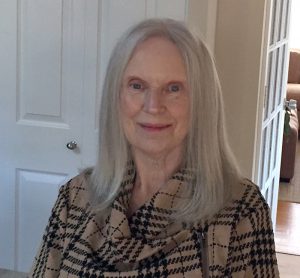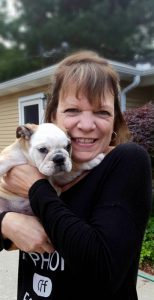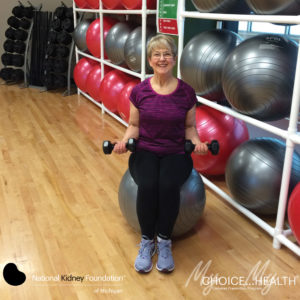
Claudia Grace improved her health during the pandemic
Livonia resident Claudia Grace thought her health was good and that she was avoiding type 2 diabetes. “It’s in both sides of my family. I thought I was doing pretty good until I realized I wasn’t,” she laughs. Her doctor referred her to the Diabetes Prevention Program because her A1C, the blood test for prediabetes, was creeping up a little each year. Not wanting to progress to diabetes, she spent the COVID pandemic year improving her health.
“It was actually a very good thing for me while being stuck in the house,” she states. Claudia, who is in her early 70s, finished the DPP in June 2021. She lost a total of 20 lbs. and reduced her A1C from 6.0 to 5.6. She is no longer considered prediabetic.
“I’m not saying this was easy,” continues Claudia. “I made up my mind that I was going to really work hard at this because I didn’t want to go into diabetes.”
Describing her starting the virtual DPP a year ago, Claudia says, “It was a real eye-opener. Writing down our food and seeing how much fat and calories was in things really helped me with my eating habits.” She shared that she and her husband ate out “all the time” and she rarely cooked at home. Now she finds herself cooking more.
Claudia found that the DPP was actually a very good thing for her while she was stuck in her house during the lockdown. With Zoom, she saw people at least once a week. “If I hadn’t been in this program,” she explains. “I would’ve been sitting on the couch, eating, anything to make me emotionally feel better. DPP gave me something to accomplish during the pandemic.”
Claudia, who describes herself as shy and was apprehensive about joining, says that her lifestyle coach Kathy always made her feel comfortable. She became energized by the group. “Doing the program over Zoom, we all share. We lift each other up; we’re happy when others do well and reach certain goals. We have a lot of laughs and we help each other when things don’t go well,” shares Claudia. “I’m not saying this was easy – it was hard to change. I had my days but then I tried to get back and work at it again.
“I walk every day. I’ve done yard work, gardening and cleaned out the garage. Even when I don’t want to get up and move, I do. I’m even seeing some definition in my arms and legs from all the activity.”
Speaking about her past attempts to lose weight, Claudia said she had tried different ways of eating, but “the DPP seemed to be the one that has taken hold and that I’ll hopefully be able to stick to.” Claudia hopes that sharing her story will help others. “It’s a wonderful program.”

Not given to the swift
by
Cynthia N. Hicks
July 6, 2020
The Diabetes Prevention Program (DPP) is a nutrition and fitness model designed to make participants aware of the proactive measures that can be taken to prevent the onset of type 2 diabetes. This progressive brainchild is the collaboration of the National Kidney Foundation of Michigan (NKFM), Western Wayne Family Health Centers (WWFHC) and Wayne State University (WSU) in conjunction with Gleaners Food Bank. Although there are several sites where this year long program is conducted, our particular group was held at the Inkster campus of WWFHC. A year later, program graduates, now known as DPP Ladies of Inkster, are more knowledgeable. Something magical happened along the way. Here’s our story. . .
The very first meeting was like peeking at a cook’s ingredients before the meal was made. You knew it was going to be fabulous! There was only a small group of us, 8 in fact, but the room was full of diversity: a lawyer, a nurse, teachers, an interior designer, entrepreneur, chef, health care professionals, sorority sisters and rivals, community workers and political advocates. Some were retired, others employed, a few were course repeaters.
I sat amazed as each gave background information. I imagined the individuals at their stated professions. But imagery faded as I began to realize that we all had the same goals and objectives for being in that particular class.
The content of DPP provided by the NKFM was thought provoking and engaging. WWFHC provided tremendous support services by allowing DPP meetings to be held at its facility and providing an awesome facilitator, Octavia Smith. Weekly meetings were wonderful! You could be an example and get an example at the same meeting. I could see something of myself in everyone and in everyone, I could see someone I admired and hoped to be. Early on, I felt it was necessary to be my authentic self. Later, I found out that others felt the same. The first leg of the DPP required 16 weekly meetings. Developing new skill sets and ultimately new friendships was a win-win.
Around week 5, fitness came into focus. After a quick evaluation, we discovered most of our group did not put aside time to exercise. To meet the program goal of 150 minutes of fitness per week, we decided to arrive 1/2 to one hour early before each meeting to walk around the parking lot. It’s funny how you will readily make sacrifices for others that you won’t do for yourself. And not long after, we were doing a 5K.
Before I delve into the significance of the 5K, I want to say a little bit about our facilitator. She is a warm and cheerful person, incredibly focused and resourceful. Her enthusiasm for health, wellness and fitness make her an invaluable asset to WWFHC and the community at large. If we had questions regarding any topic we were curious about, not only did she cover the material, she provided supporting documentation. On more than one occasion, she brought in a nutritionist to answer our dietary questions. We were encouraged to take advantage of a plethora of resources right in our own community. Her affiliation with a federally qualified health organization, not to mention her natural networking abilities, put us in line for great opportunities such as: cooking classes, Inkster community events like the citywide garage sale, and small business support day, to name a few. She introduced us to and provided us with so much additional documentation and resources that they required a binder and bag of their own. Her daily texts and greetings almost always included reminders of our goals. She often said, “View each day as an opportunity to try again”. She had a gentle way of firmly nudging you in the right direction.
When our facilitator told us about the MOTTEP (Gift of Life’s Minority Organ Tissue Transplant Education Program) Foundation 5K challenge in 2019, the majority of us had never participated in any type of organized walk/race. It was exciting but scary. Some had walked no further than around the WWFHC parking lot, so the 5K seemed daunting. Our facilitator urged us to start where we were.
Once we defined a kilometer, dismissed the “I will never be able to. . .” thinking, training began. Garden City Park (GCP) was chosen as our new training ground. The 5K was a little more than 90 days away and we met biweekly from that point on – one day for the DPP meeting, one day at GCP for 5K training. Individual strengths were identified. Areas of struggle were disclosed in a safe and supportive environment where there was no judgment. Encouragement was the rallying call.
One member, a notorious night owl, who often arrived late to meetings and hated morning meetings, volunteered to lead the group in stretches before we started our walk practice each week. Surprisingly, she never arrived late for her 5K training assignment, which was scheduled earlier in the morning so we could beat the noonday sun.
An older, soft spoken member was left on the bench resting to catch her breath the first or second time we went out to practice. It was weeks before she told us that the group she was walking with never came back to get her. She vowed never to be left behind again. Today, our little benchwarmer can walk circles around most of us. You got to get up mighty early if you want to catch or keep up with her now!
Another member who never gave herself much credit, could not see herself walking around the park. After gaining confidence and learning a few techniques, she began sharing what she learned with others. Now, even one year later, people in the group and others that she has inspired, give her all the credit.
Of course, I suspect every group has one — a fierce multitasker. Ours is one of the oldest members of the team. If there were nanoseconds on a planner, she would have something scheduled! She comes to training and maximizes her time and effort spent there. One way she accomplished that was by scaling the hill. It seemed insurmountable to the rest of us. If you ever saw her do it, you’d be standing with your mouth agape while she voice texts you adieu on her way out of the parking lot to her next appointment. But we all tried it at least once.
Communication was the key. We listened to each other. We respected each other. We learned the program content and how to apply it. We shared best practices with each other and with family and friends. We were proud to be participants in the 5K. Time went by so quickly, spring, summer and fall. The first leg of the program was now behind us.
The 5K practice run took place on the site where the 5K walk was scheduled to be held, the Inkster Golf Course. Did I mention we had a few golfers in the group? One of them contacted management who agreed to allow us access to the course for our dry run. It was a cool late fall afternoon and the brisk breeze rustled the flags on their poles in the sea of sand and grass of the beautifully manicured greens. As we strolled the fairway, our guide and teammate explained the difference between a “long and short game”. (I, myself, believe I would excel at the short game. I’ll know for sure when I get the “free golf lesson” she promised.) Also, she told us a delightfully humorous story about how a snake got in her basement and met his demise. As the sun approached the horizon, we had walked the golf course in preparation for the 5K! In hindsight, we didn’t think much of it; we were in training.
The big day finally arrived. We all could don our t-shirts and show our community, each other, and ourselves what we were made of. This was the most precious moment, when you realized that each one started as an individual at a different spot in the race. But, with patience and perseverance, we crossed the finish line together as a team.
At this point, DPP no longer determined how often we communicated. We spoke almost daily. Supporting the community included the personal support of each other. Acknowledgment of holidays, birthdays, and anniversaries was commonplace. If a team member had transportation issues or just needed/wanted something from your side of Michigan Ave, all they had to do was say the word. We had become sisters. You received praise for your personal bests and triumphs. Challenges and setbacks warranted support.
In March 2020, our nation was hit with the coronavirus pandemic. The entire state of Michigan was in lockdown. Stay at home orders issued by our governor meant that all monthly DPP classes were cancelled until further notice. Therefore, we initiated our own Zoom meetings in an effort to remain in touch.
We have completed the DPP and are officially graduates. For our first-year anniversary, we completed our second 5K walk. Because of COVID-19, this was a virtual challenge. We concluded with raised victory arms, 6 feet apart, right back where we started one year ago at Garden City Park.
In conclusion, as we look back at how far we have come together, and how much each of us has learned about type 2 diabetes prevention over the past year, we know that none of this would have been quite the same without each other. It would have been almost impossible without the support and content from WWFHC and NKFM. However, the glue that held it all together was the facilitator, mentor and friend, our sister, Octavia Smith.
 Julie Leslie
Julie LeslieParticipant, Diabetes Prevention Program
Since she joined the Diabetes Prevention Program in February 2018, Julie Leslie says she doesn’t feel her age.
Through the CDC-certified program, she lost 31 pounds, lowered her blood cholesterol and reduced her A1C (blood test that measures blood sugar over three months) from 6.4 to 5.9.
“My doctor was going, ‘Tell me all about this program!’,” she said. “People tell me I don’t look 62, and I don’t feel it either.”
Leslie joined the program shortly after she was diagnosed as prediabetic. A kidney cancer survivor, she heard about the program through the National Kidney Foundation of Michigan.
While many people are familiar with type 2 diabetes, fewer are aware of prediabetes, a health condition that affects over 2.6 million Michiganders (more than 1 in 3) and often leads to type 2 diabetes. To help curb this epidemic, the National Kidney Foundation of Michigan began their Diabetes Prevention Program (DPP.)
“My mom is a diabetic and has been for 20 years. I see her struggles, and I said I don’t want to do it either,” she said. “I just said I am going to lose weight. The two things that got me was the diabetes and that I wanted to lose weight. And it worked!”
Although she had always been physically fit, Leslie’s blood sugar and A1C had been increasing over the years. Through the program, she learned to track her food intake and began eating healthier and fewer processed foods. She also learned ways to cook without fat, and welcomed the alternative recipes the group would share at the weekly classes. Now, she is encouraging others to sign up for DPP when it’s offered
 Mary Jo Frank
Mary Jo FrankParticipant, Diabetes Prevention Program
After trying commercial weight loss programs, Mary Jo Frank of Dexter, Michigan had given up on reaching a healthy weight. But after encouragement from a friend, she joined the Diabetes Prevention Program in January 2015. She started the program thinking she was “too old” to lose a significant amount of weight. Boy, was she wrong.
“Among the program’s many strengths are the enthusiastic instructors who lead meetings and are available in between to encourage and answer questions,” said Mary Jo. “The Diabetes Prevention Program also encourages setting a realistic, attainable weight loss goal.”
Mary Jo has completed the year-long program and surpassed her original weight loss goal, totaling over 25 pounds!
Mary Jo is committed to living a healthy lifestyle. She enjoys wearing a smaller size and hearing compliments, but knows this program is about more than the frills.
“The biggest payoffs are feeling stronger and more energetic and knowing I’m doing what I can to avoid diabetes.”
 Alan Zander
Alan ZanderParticipant, Diabetes Prevention Program
Alan Zander, resident of Farmington Hills, joined the National Kidney Foundation of Michigan’s Diabetes Prevention Program in January 2015. After Alan learned from his doctor that he had prediabetes, he knew he had to make some lifestyle changes.
“This program had a light at the end of the tunnel that seemed like it could actually do something for me. This was the first program I tried that was a real lifestyle change and not a diet.”
Alan really enjoyed that the DPP builds upon itself, and teaches the lifestyle changes gradually over the 16 weekly sessions. Alan explained that because the changes he made were minor, he eventually hit his goals.
“The program was simple for me because of the way we started off by just tracking our food intake, and not counting calories. As the program went on and I began tracking fat grams and physical activity it came very easy to me.”
Alan’s positivity and determination to live a healthier life helped him to lose 40 pounds at the end of the first 16 weeks!
“I don’t encourage my friends and family to think about joining the Diabetes Prevention Program, I encourage them to just plain do it!”
 Lauretta Zandstra
Lauretta ZandstraParticipant, Diabetes Prevention Program
Lauretta has a family history of type 2 diabetes and knew she had to make lifestyle changes in order to prevent the disease herself.
“I knew this program was what I needed to start living a healthier life,” said Lauretta.
Research shows that by losing a modest amount of weight – 5-7 percent of your body weight – and being physically active for about 30 minutes a day, 5 days a week, a person can prevent or delay the onset of type 2 diabetes.
Lauretta enrolled in the Diabetes Prevention Program in January of 2014 in Grand Rapids. Lauretta explained that she was shocked during her first class.
“I was surprised how diverse the group of participants were. I thought everyone was going to be overweight and just trying to lose weight. But people at risk for diabetes truly come in any shape, size, and age,” said Lauretta.
One lifestyle change Lauretta has made since starting the program is planning her meals a week in advance. This makes it easier for her to eat healthy foods.
“Planning my meals and tracking what I eat really opened my eyes. I’m more conscious of what I put in my mouth now because I’m aware of the nutritional value of the food I eat,” Lauretta said.
Lauretta explains she’s eliminated a lot of food items from her kitchen, for example, potato chips and dip. She realized that when she was emotionally triggered she would reach for snack food, which was an unhealthy habit. Eating used to fill an emotional void in Lauretta’s life, but she now has other things to turn to since participating in the Diabetes Prevention Program.
“If I’m feeling stressed, I’ll exercise, or get a massage or manicure. It’s important to do something nice for yourself sometimes,” said Lauretta.
Since starting the program, Lauretta has lost 37 pounds, and is working on losing another 30-40 pounds. She says she would recommend this program to anyone at risk of type 2 diabetes who is willing to make necessary healthy lifestyle changes. Lauretta says she keeps her goals in the present, and that she is feeling much healthier since she’s made lifestyle changes.
“Participating in this program is a process. You have to set a goal and work towards it. It’s hard work, but it’s worth it!”
 Crystal D’Agostino
Crystal D’AgostinoParticipant, Diabetes Prevention Program
Crystal D’Agostino, a Senior Program Coordinator at the National Kidney Foundation of Michigan, was diagnosed with gestational diabetes about five months into her first pregnancy. This diagnosis was frustrating for Crystal, who was familiar with the disease through her work at the NKFM and had put a lot of effort into trying to avoid this diagnosis.
Being diagnosed with gestational diabetes does not mean that a person had diabetes prior to becoming pregnant or that she will have it after giving birth. According to the CDC, shortly after pregnancy, 5% to 10% of women with gestational diabetes continue to have high blood glucose levels and are diagnosed as having diabetes, usually type 2. It is important, however, to keep blood glucose levels normal. Treatment of gestational diabetes requires special meal plans, physical activity and, in some cases, daily blood glucose testing and insulin injections.
A major component of diabetes management is making healthy food choices. Upon learning of her gestational diabetes, Crystal immediately began a diet to manage her blood glucose levels.
While Crystal was able to manage her gestational diabetes for a few months with a restricted diet and increased exercise, she soon learned that she needed insulin injections. For the last two months of her pregnancy, Crystal was required to take insulin injections every night before bed. Due to an allergic reaction, she frequently had to work around welts. She admits that these last few months were hard, even with the support of her husband, who administered the insulin.
“I hated having to go through that and repeatedly getting stuck by a needle from the insulin and through finger pricks,” says Crystal.
After having a healthy baby girl, Crystal was determined not to have gestational diabetes in her future pregnancies. She continued the “diabetic diet,” getting down to five pounds under her pre-pregnancy weight. At this point however, her weight loss plateaued and she decided to enroll in the NKFM’s Diabetes Prevention Program.
“The physical activity was something that I struggled with, being a full-time working mom with a toddler,” explains Crystal, “but once I moved past the mom guilt and figured out ways to have my daughter and I still spend time together while I worked out, things seemed to fall into place.”
Crystal says that the Diabetes Prevention Program changed her perspective on the idea of what physical activity means.
“I had to change my idea of what physical activity was for me,” says Crystal. “Before, I mostly thought of physical activity as running and taking classes, but as a new mom, it was a struggle to find time to do these things on my own. This program taught me to redefine physical activity.”
By the end of the program Crystal learned that she was pregnant with her second child. She adjusted her diet for the baby and remained active through prenatal yoga and walking. When it came time to be tested for gestational diabetes, she was shocked and excited to learn that she did not have it again, especially considering her the preexisting issues in her family.
Crystal demonstrates how getting educated, making healthy lifestyle choices, and finding a support system can help you to control your health.
Attend a free information session to get answers to any questions you have have about the Diabetes Prevention Program.